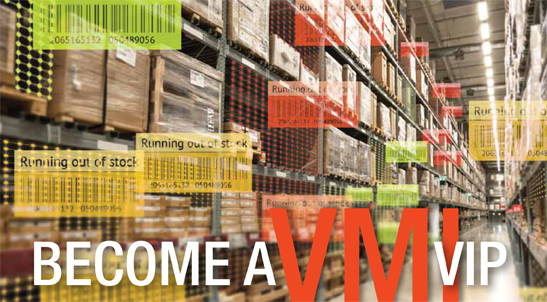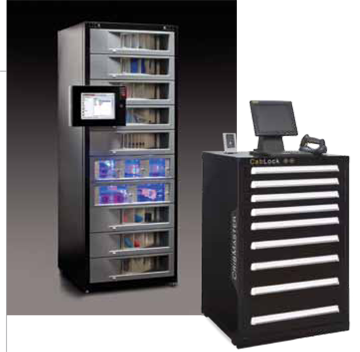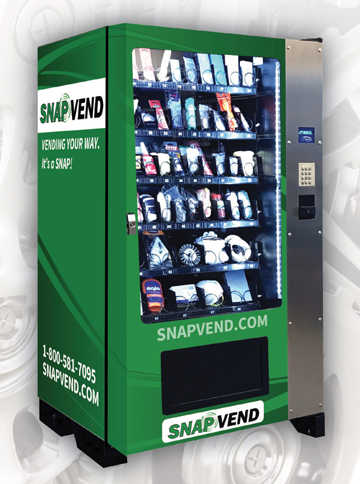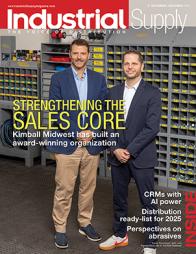Become a VMI VIP

by Rich Vurva
As this issue’s cover story demonstrates, distributors that excel at managing inventory for customers can gain a foothold that is difficult for competitors to break. Whether managing OEM or MRO supplies, the knowledge gained about parts consumption within a manufacturing plant can help uncover opportunities to eliminate waste and improve production.
The industrial vending market is expected to reach $1.4 billion dollars by 2025, according to Grand View Research. Inventory challenges like high carrying costs, shrinkage and stockouts are causing customers to look for more effective and precise ways to manage their inventory. Customers are looking to reduce inventory consumption, improve accountability and visibility, and gain real-time control over their inventory. A combination of a point-of-use system like a vending machine combined with a cloud-based software solution can provide all of those benefits.
Using industrial vending machines and other inventory control solutions from companies such as Cribmaster, SnapVend and 1sourcevend, distributors can help their customers gain a better understanding of their consumption of cutting tools, personal protective equipment and a myriad of other parts and supplies.
“Because of the increasingly affordable cost of technology today, distributors are now in prime position to compete for larger accounts against major companies like Fastenal. By focusing on vending as a value-add for their customers, distributors can strengthen existing relationships as well as capture more monthly spend that they may have missed before implementing vending as a solution,” says Mark Hill, founder of 1sourcevend.
Hill adds that the market for machines and inventory-control programs is also growing.
“It used to be that machines were so cost-prohibitive that they didn’t make sense for smaller customer facilities. But providers have entered the market (including ourselves) offering an affordable but effective vending machine option, which has opened vending to smaller facilities and slower-moving and lower-margin products. Keeping it simple may be better in many cases, as the more bells and whistles a machine and its associated software has, the more difficult it may be to setup and maintain. We’re seeing great growth among local and regional distributors in placing vending machines and inventory-control programs with smaller customers.”
Hill believes that distributors have better results when they view vending as a value-add they provide their customers and place the machine for free, rather than attempting to sell a machine. In fact, approaching vending as something to be marked up can result in less profit for the distributor. “Our competitive pricing allows distributors to compete on a level playing field and implement machines at no charge and still make more profit,” he says.
Distributors should ask for additional overall spend from that customer (from inside and outside the machine). When viewed as an inventory-management solution rather than a product, distributors also see greater customer satisfaction and loyalty. Increasing customer retention by just 5 percent can lead to increased profits of 25 percent to 95 percent (source: Invesp).
In addition, customers can see inventory reductions of up to 30 percent, and distributors can save on the labor that was previously required for in-person inventory counts and quote generation.
Distributors should consider differentiating from larger competitors with more customized inventory management programs, offering more flexibility to customers on things like billing frequency, consignment, product requirements and so on. Independent distributors shouldn’t limit themselves to one specific vending program. They can be flexible and design each vending program to suit each customer’s needs. As long as customers agree to increase overall volume in exchange for machine access, it shouldn’t matter what they’re buying.
“Distributors are often reactive in placing vending machines, waiting until a customer requests one or their business is at risk. Leverage inventory control through vending as a value-added service proactively to protect and grow accounts. The best defense in this case is a good offense,” Hill says.
Inventory-control software
The inventory-control software provides the real power behind vending. Users log onto a cloud system to manage inventory in customer machines, set mins and maxes, and get alerts when stock runs low. The 1sourcevend proprietary vendor-managed software provides real-time reporting on inventory, avoiding stockouts and helping customers track and control usage at the point of use.
The 1sourcevend software is cloud-based, offering customers measurable cost savings and distributors significant cost reductions. Often, the software can be configured while waiting for the machine to arrive, essentially removing any downtime associated with the set-up of a new vending machine.
A variety of vending machines are available, all with an integrated touchpad that require just a simple PIN or card-swipe login with RFID. They use wi-fi, cellular network connectivity or hardwire, meaning the machines can be put anywhere. Users select from actual product images on the screen, organized in the same way they are in the machine. Coil and locker solutions offer flexibility to vend multiple SKUs in the same machine.
 Service and value
Service and value
“An industrial distributor’s success is driven by their service and the value they are able to bring their customer,” says Mindy Castellanos, strategic account manager for CribMaster. “Inventory management equips distributors with the ability to offer efficiencies through labor savings, cost reduction, and administrative synergies. A solid VMI program is a win/win for the industrial distributor and their customer as it adds value to both parties while strengthening the supplier/customer relationship.”
She says CribMaster offers a host of software and hardware solutions that are customized for each customer’s specific needs. For example, CribMaster’s ProStock solution lets users manage varying quantities of indirect materials within a small footprint. Secure and highly configurable, the ProStock features carousels and lockers to accommodate small and large consumables and durables.
 “When assessing a solution for a customer, our team will answer questions about the environment, the material to be managed, and any customer pain points. From those answers we help create a solution according to the needs of that specific customer,” Castellanos says. “At CribMaster we differentiate ourselves by our software which is the cornerstone of each of our solutions. We also excel in our ability to scale, we have the unique capability to start small and exponentially grow with any customer.”
“When assessing a solution for a customer, our team will answer questions about the environment, the material to be managed, and any customer pain points. From those answers we help create a solution according to the needs of that specific customer,” Castellanos says. “At CribMaster we differentiate ourselves by our software which is the cornerstone of each of our solutions. We also excel in our ability to scale, we have the unique capability to start small and exponentially grow with any customer.”
Another vending solution, the CabLock, is ideal for establishing accountability among employees of high-use supplies required at the point of use. Workers have easy access to material through a simple user interface. The industrial cabinet design offers multiple configuration choices for the drawers and compartments, creating organized storage of bulk inventory such as fasteners, rivets, or hardware. It can also be used to track durable items such as tools.
“Developing a new program for customers which incorporates software and hardware into a solution may seem like a challenge initially,” Castellanos says. “However, vending is a tried technology with proven results. As we see vending becoming more commonplace in our markets I would encourage anyone interested in bringing value to their customer to have a conversation with their account manager to learn more about how they can best serve their customer. We have the opportunity to be our customer’s hero, reducing their stress, and making their lives easier. I’m not sure there is anything more professionally fulfilling than that.”
Implementation challenges
 When a distributor decides to provide a vending solution for customers, it’s important that it becomes a core competency, says Mike Burchett, national account manager for SnapVend. He says the solution touches customer service, the warehouse, and the delivery team, and to really make it work, a distributor must have a top-down mandate that this is a way to build a moat that Amazon and other competitors cannot easily penetrate.
When a distributor decides to provide a vending solution for customers, it’s important that it becomes a core competency, says Mike Burchett, national account manager for SnapVend. He says the solution touches customer service, the warehouse, and the delivery team, and to really make it work, a distributor must have a top-down mandate that this is a way to build a moat that Amazon and other competitors cannot easily penetrate.
“Distributors have to get comfortable calculating cost to serve, packaging and delivering product, and offsetting against the benefits of automated order entry, reduced stockouts and increased customer longevity. There is a well known national competitor that has gone all in with vending, and has really solid results. Our solution was theirs at one time, and we think is the best one to directly compete, and distributors just have to think outside the box (if the box is a big vending machine), and use their investment in their customers success to capture other spend categories,” Burchett says.
 Burchett says 90 percent of SnapVend solutions are coil machines or lockers because they are low maintenance and less expensive to implement. “Our solutions in many cases are half to a third of the price of the competition, yet the software that drives them is extremely powerful, capable and feature rich, so we can set limits, track regrinds, check out and return items, job track, integrate with ERP systems and set auto alerts and reports,” he says.
Burchett says 90 percent of SnapVend solutions are coil machines or lockers because they are low maintenance and less expensive to implement. “Our solutions in many cases are half to a third of the price of the competition, yet the software that drives them is extremely powerful, capable and feature rich, so we can set limits, track regrinds, check out and return items, job track, integrate with ERP systems and set auto alerts and reports,” he says.
He adds that SnapVend provides a variety of training opportunities to help distributors get up to speed.
“At SnapVend, we’ve tried to eliminate as much confusion in the learning process by promoting training opportunities at a distributor level as well as the consumer/procurement level using webinars and training videos,” he says. SnapVend offers customer-facing presentations to make sure the concerns and questions of distributors and their customers are addressed.
“Distributors are faced with the reality that customers don’t want to pay for equipment and don’t want to pay for product until they’ve dispensed it from the vending system,” Burchett says. That makes it challenging for distributors to calculate a return on investment.
“However, we see success story after success story from our network of distributors,” Burchett concludes.
This article originally appeared in the May/June 2019 issue of Industrial Supply magazine. Copyright 2019, Direct Business Media.













